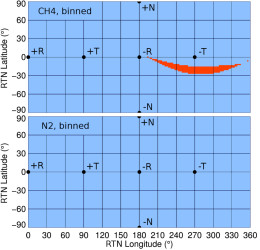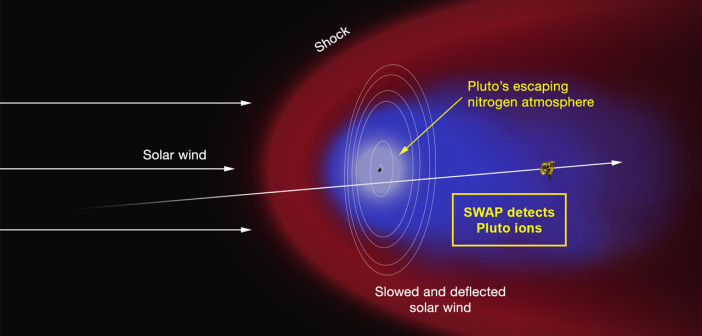Nearly a year ago, in July 2015, the New Horizons spacecraft passed by the Pluto system. The wealth of data amassed from that flyby is still being analyzed — including data from the Solar Wind Around Pluto (SWAP) instrument. Recent examination of this data has revealed interesting new information about Pluto’s atmosphere and how the solar wind interacts with it.
A Heavy Ion Tail
The solar wind is a constant stream of charged particles released by the Sun at speeds of around 400 km/s (that’s 1 million mph!). This wind travels out to the far reaches of the solar system, interacting with the bodies it encounters along the way.

By modeling the SWAP detections, the authors determine the directions of the IMF that could produce the heavy ions detected. Red pixels represent IMF directions permitted. No possible IMF could reproduce the detections if the ions are nitrogen (bottom panels), and only retrograde IMF directions can produce the detections if the ions are methane. [Adapted from Zirnstein et al. 2016]
Escaping Methane
In a recent study led by Eric Zirnstein (Southwest Research Institute), the latest analysis of data from the SWAP instrument on board New Horizons is reported. The team used SWAP’s ion detections from just after New Horizons’ closest approach to Pluto to better understand how the heavy ions around Pluto behave, and how the solar wind interacts with Pluto’s atmosphere.
In the process of analyzing the SWAP data, Zirnstein and collaborators first establish what the majority of the heavy ions picked up by the solar wind are. Models of the SWAP detections indicate they are unlikely to be nitrogen ions, despite nitrogen being the most abundant molecule in Pluto’s atmosphere. Instead, the detections are likely of methane ions — possibly present because methane molecules are lighter, allowing them to more efficiently escape Pluto’s atmosphere.
![Reconstructed origins of heavy ions detected by SWAP shortly after New Horizons’ closest approach to Pluto. Color represents the energy at the time of detection. [Adapted from Zirnstein et al. 2016]](https://aasnova.org/wp-content/uploads/2016/05/fig37-260x211.jpg)
Reconstructed origins of heavy ions detected by SWAP shortly after New Horizons’ closest approach to Pluto. Color represents the energy at the time of detection. [Adapted from Zirnstein et al. 2016]
Magnetic Direction
New Horizons does not have a magnetometer on board, which prevented it from making direct measurements of the interplanetary magnetic field (IMF; the solar magnetic field extended throughout the solar system) during the Pluto encounter. In spite of this, Zirnstein and collaborators are able to determine the IMF direction using some clever calculations about SWAP’s field of view and the energies of heavy ions it detected.
They demonstrate that the IMF was likely oriented roughly parallel to the ecliptic plane, and in the opposite direction of Pluto’s orbital motion, during New Horizon’s Pluto encounter. This would cause the solar wind to deflect southward around Pluto, resulting in a north-south asymmetry in the heavy ion tail behind Pluto.
The new knowledge gained from SWAP about the geometry and the composition of Pluto’s extended atmosphere will help us to interpret further data from New Horizons. Ultimately, this provides us with a better understanding both of Pluto’s atmosphere and how the solar wind interacts with bodies in our solar system.
Citation
E. J. Zirnstein et al 2016 ApJ 823 L30. doi:10.3847/2041-8205/823/2/L30


1 Comment
Pingback: Pluto has a tail!